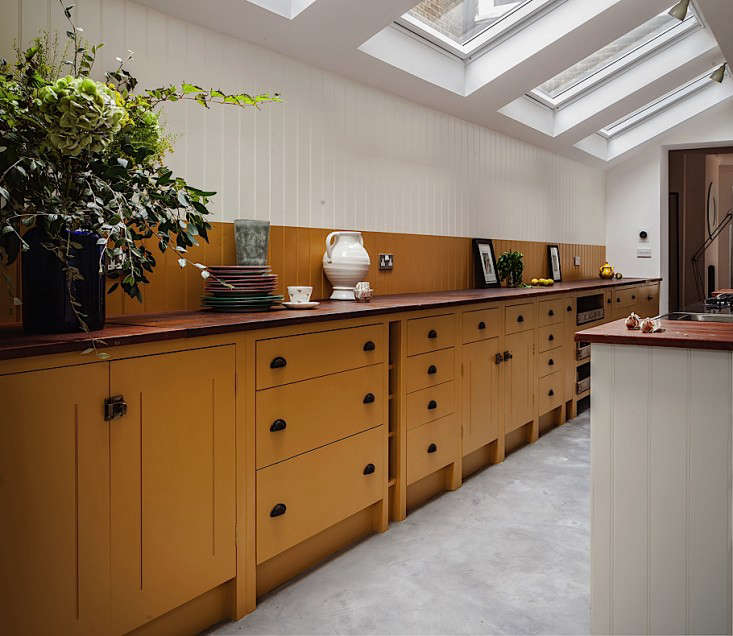Your basement is like a pair of shoes: just like a poor-quality, run-down pair will affect things much higher up (like your posture), a run-down, uncared-for basement will affect your whole house. Which is why it’s time to start thinking of your basement as an important foundation (literally) for a healthy living environment—not just a dark, unloved, and potentially creepy space to store all of your stuff. In this week’s installment of 10 Things Nobody Tells You, our new weekly guide for newbie remodelers, we uncover a few things you might not know about the under-appreciated room beneath you (and how to care for it).

1. Your basement should be part of your cleaning routine.
There’s a temptation to follow the “out of sight, out of mind” rule and let your basement grow cobwebby and untouched. Don’t. For reasons that are about to become clear, you should think of your basement as an important room in your house and maintain it with the same level of care. That means regular cleaning, airing-out, and, yes, weeding out.

2. You’re probably breathing basement air.
The damp, stale air in the basement stays down there, right? Wrong. Thanks to something called the “stack effect”, the air in your basement travels up through your house, becoming the air in your kitchen, living area, and bedroom. If that air is moldy or damp, it can affect your health (the CDC reports that, according to a study by the Institute of Medicine, damp living environments are linked to upper respiratory problems, coughs, and asthma). That’s in addition to the threat of radon, a harmful gas that can seep in from the surrounding soil and rocks and build up in the basement. All the more reason to pay close attention to your basement health—keep it as clean and dry as possible (more on that next) and perhaps buy a radon detector.
3. At some point, you’ll have leaks.
Your basement is, at its most basic, a hole in the ground. Think of it like digging a hole in the sand at the beach: Eventually, there will be at least some dampness, or even leaks, down there. (FEMA estimates, rather distressingly, that 98 percent of houses will have a wet basement at some point.)
What’s important is what you do about it. Inspect your basement regularly for signs of moisture or leaks, and stay on top of it: Seal any potential sources of leaks or moisture and insulate pipes, run a dehumidifier, consider installing a sump pump, and clean up any leaks or standing water with a shop vac and air out thoroughly. And, ensure you have a well-working drainage system outside (for more on that, see 10 Dramatic Drainage Ideas to Steal and Hardscaping 101: Rain Gutters on Gardenista). It might also be a good idea to buy a smart leak detector: Especially if you’re away or on vacation when a leak or flood happens, you’ll know—and can act—right away, minimizing damage.

4. Cardboard is the enemy.
Cardboard is a known favorite of the universally hated insect called silverfish—and it can act as a breeding grown for mold and mildew. Plus, it’s just not built to last. While it might be tempting to re-use cardboard boxes and stuff them downstairs, take the time to invest in something sturdier and sealable—like metal or, dare we say it, well-designed, recycled plastic—for basement storage.

5. Have a pest problem? Check the basement.
Let’s not delude ourselves: a few bugs and mice are bound to take shelter in your basement. But if you’re noticing insects or rodents upstairs, there’s a good chance that paying more attention to your basement can help. A few things you can do, according to Massachusetts-based Colonial Pest Control: seal basement cracks and crevices, get rid of or seal any food stored in the cellar (including birdseed and pet food), clear debris from the window wells, resist the urge to stack wood in or around the basement, and—most importantly, for deterring bugs—keep the moisture level as low as possible.
6. You’ll need to ventilate your boiler.
Boilers, some people forget, need proper air flow in order to work well and safely. If you’re buying a house, considering a basement remodel, or just want to check on the health and safety of your boiler, consult a professional to be sure the boiler is safe and has enough room to breathe.
7. A renovated basement bumps your house’s value way up.
Thinking about taking on a remodel? You might want to start with the basement. HGTV reports that, according to Remodeling magazine, the average basement remodel costs about $60,000. But, with a 70.3 percent payback, it has one of the highest returns on investment of any house project.

8. Covering up the unsightlies might pose a risk.
Fan’s basement was finished when she and her family moved in, and it looked great: no exposed pipes or utilities in sight. But whoever closed in the ceiling neglected to insulate properly. The problem? The pipes that run along the ceiling weren’t insulated, nor were they getting ambient heat from the room, putting them at risk to freeze. Moral of the story: Don’t be too quick to add a drop ceiling as part of your remodel, and if you do, be sure to include insulation.
9. And, hold off on the carpeting.
New homeowners should resist the urge to install wall-to-wall carpeting right away. “Live there for a few rainy seasons first,” says Fan. If your basement stays dry through winters and springs, go ahead with the carpet.

10. Assessing foundation cracks = palm-reading for houses.
Take a careful look in and around the basement when you’re looking at a house: It can provide vital clues to the health of the house you’re buying. For example, poor drainage and puddles around the house or visible moisture and mold in the basement can cause big problems. Cracks in the foundation larger than an eighth of an inch are a sure red flag. But some hairline cracks? Those are probably not a big deal, though you’ll want to hire at least one professional inspector anytime you’re seriously considering a house to be sure. (See more warning signs in 8 Small Signs that Signal Big Problems and 6 Problems that Shouldn’t Be Dealbreakers.)
Another sure sign of basement trouble? If a house has an unfinished basement and it looks like everything is intentionally raised off of the floor, there’s a good chance it floods often. Additionally, if you’re buying, you can look for a listing with a Basement Health Certificate, a certification given out by a couple of basement-health bodies that states the basement’s in good shape. You might want to look into this if you’re selling, too.
For much more in this series, see:
- 10 Things Nobody Tells You About Renovating Your Kitchen
- 10 Things Nobody Tells You About Painting Floors
- 10 Things Nobody Tells You About Subway Tile
- 10 Things Nobody Tells You About Painting Furniture
- 10 Things Nobody Tells You About Washing Your Bedding
- 10 Things Nobody Tells You About the Trendiest Tile of 2019
- 10 Things Nobody Tells You About Renovating Your Bathroom
- 10 Things Nobody Tells You About the Benefits of Wool
- 10 Things Nobody Tells You About Clawfoot Bathtubs
- 10 Things Nobody Tells You About Painting Kitchen Cabinets
- 10 Things Nobody Tells You About Shiplap
- 10 Things Nobody Tells You About Marble Countertops
- 10 Things Nobody Tells You About Painting a Room White




Have a Question or Comment About This Post?
Join the conversation (1)